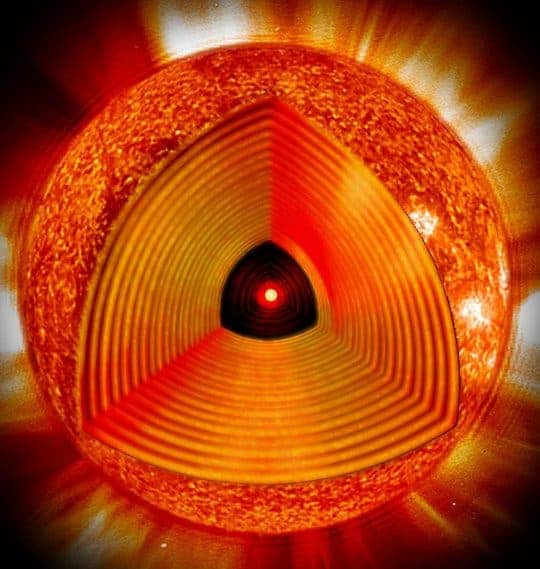For the first time, an international team of astronomers used stellar oscillations to determine the inner structure of two stars. Their work reveals that not everything is as we believed in the core of these hot bodies.

As different as stars and planets may be, the internal processes inside both can form and then carry seismic waves. In essence, these are acoustic waves, propagating through compression and decompression in elastic substances (in geology, bodies like rocks and stars are considered elastic). On Earth, more powerful seismic waves generate earthquakes. In stars, the equivalent process causes a ripple across the surface, altering their light output, in a phenomenon known as stellar oscillation.
An international team of astronomers led by Earl Bellinger of the Max Planck Institute for Solar System Research in Göttingen has, for the first time, used these oscillations to map the inner structure of two nearby stars in the 16 Cygni system, located 69 light years away from Earth.
Bending light
Similarly to how seismologists use earthquakes to tease out the inner structure of our planet, astronomers can use the dips and peaks in light emissions of stellar oscillations to “peer” into the cores of stars — a field known as asteroseismology. The team performed a detailed asteroseismological analysis of the pulsations from the two stars, 16 Cyg A and 16 Cyg B, enabling them to measure their internal structures.
“Due to their small distance of only 70 light years, these stars are relatively bright and thus ideally suited for our analysis,” said Earl Bellinger. “Previously, it was only possible to make models of the stars’ interiors. Now we can measure them.”
The advance was made possible by the team’s innovative approach. The field of asteroseismology has been around for a while now, but so far it’s only produced models of stellar interiors, not actual measurements. To create such a model, astrophysicists start from a general model of a stellar interior and then tweak it progressively until it fits the light frequency spectrum recorded from a star. It works really well if you don’t need a lot of precision. There’s still a lot we don’t understand about how stars function, so the oscillations we can calculate for these generated models aren’t exactly true to reality — this means that the models we come up with will fit reality in broad terms, but will still fail to explain some details.
Bellinger’s team used an inverse method to study the stars. Instead of creating models, simulating their output, and comparing it to the data, they looked at the light frequencies and reverse-engineered that into a model. It’s a very powerful tool in geophysics, but the caveat is that it’s spectacularly easy to mess up an inverse method. You can also end up with a solution that mathematically explains what’s going on, but doesn’t have a real physical foundation. Another issue is that inverse methods never have a single ‘right’ answer. You can have several solutions that are equally good at explaining the observed phenomenon, so you don’t know which one to choose.
Overall, inverse solutions live and die by the quality of available data and are very tough mathematical nuts to crack. However, as long as they’re grounded less in theoretical assumptions and more in practical realities, it’s still possible to crack them. This is exactly what the team needed in this case.

Image credits Earl Bellinger / ESA
Through this method, the team looked more than 500,000 km deep into the stars and found that the speed at which seismic waves travel within the central regions is higher than that predicted by previous models.
“In the case of 16 Cyg B, these differences can be explained by correcting what we thought to be the mass and the size of the star,” says Bellinger.
In the case of 16 Cyg A, however, the cause of the discrepancies could not be identified. It’s possible that the current evolutionary models of the star underestimate or simply miss certain physical phenomena.
“Elements that were created in the early phases of the star’s evolution may have been transported from the core of the star to its outer layers,” explains Bellinger. “This would change the internal stratification of the star, which then affects how it oscillates.”
Bellinger says this first structural analysis will be followed by many more. Data from between ten to twenty more stars suitable for such an analysis has been recorded by the Kepler Space Telescope, and NASA’s upcoming TESS mission (Transiting Exoplanet Survey Satellite) and the PLATO (Planetary Transits and Oscillation of Stars) space telescope planned by the European Space Agency (ESA) will collect even more data for this research field.
The paper “Model-Independent Measurement of Internal Stellar Structure in 16 Cygni A and B” has been published in The Astrophysical Journal.


